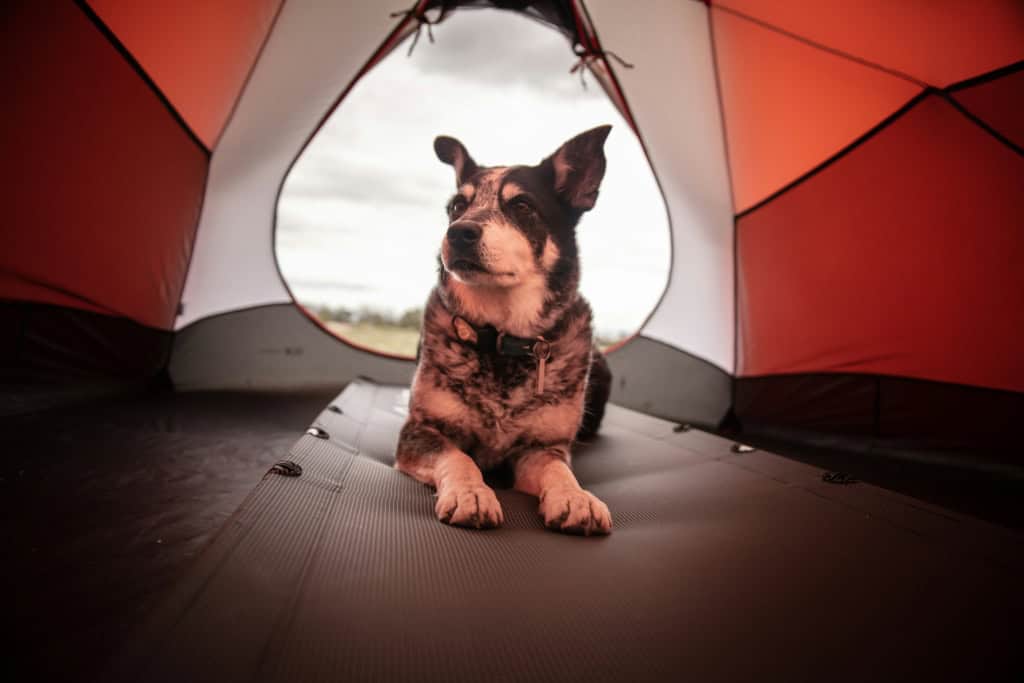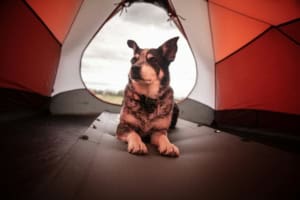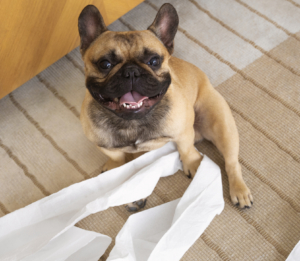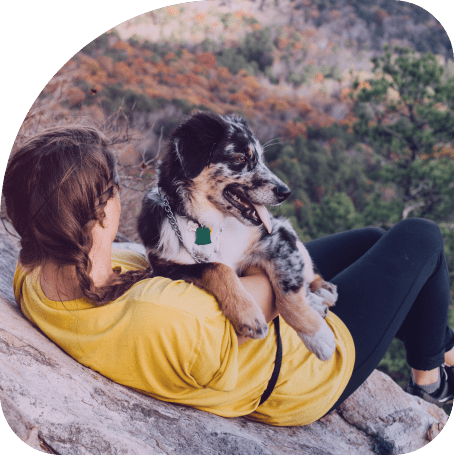One of the most adored summertime activities is camping, and most of us want to bring our canine family members along for the adventure! However, there can be challenges and risks associated with bringing our pups camping. In this blog, we’re going to outline some tips, tricks and things to consider when camping with our canine companions.
Before you go
If you have a dog who can struggle to adapt to new environments or stimuli, it’s important to recognize that camping may be challenging for them. Just like for some of us, new experiences can be anxiety-inducing. Alternatively, new experiences can also be rewarding and enriching to our lives, especially when we manage our expectations, and proactively set ourselves, and our dogs, up for success. So, before heading out on a camping trip with your dog it’s worth doing some planning and also putting in the time to consider whether or not you think your dog is ready for this experience and if it would enrich their life, or not..
Some questions to think about:
- Is this something you both can enjoy together?
- For example: Are you both ready for potential challenges that could arise, such as noisy camping neighbors, dogs walking past your campsite, dogs camping in the site beside you, kids running around? Your dog needing to be tethered in the campsite? Do you think you both can cope and find solutions? Or will it be too stressful for both of you?
- Is the weather appropriate for them?
- For example: Is it the hottest time of year? Does your dog do well in the heat? Will there be enough shade and reprieve for them from the heat? Remember~you can’t leave your dog in the car, or in a tent, if it’s hot out!
- Do they have the general skills to succeed (i.e. basic obedience training and decent social skills, would be the bare minimum that you will need)?
- For example: Do they know how to go settle on their bed when asked? Walk nicely on a leash to walk through the campground? Come when called in case you can let them run off leash at the beach or in the forest? Know how to behave on a long leash in case you can’t let them off leashIs your dog physically healthy enough? Will they freak out if the park ranger, some kids, or a camping neighbor walk into your campsite unexpectedly?
Great! Now that you’ve reflected on those things, it’s time to prepare your dog for the sounds, smells and general equipment involved with camping. We recommend that you desensitize your dog to as many camping-related things as possible before going. This can look like:
- Setting up your tent in the house, or even better, somewhere outside, and spending some relaxing time together inside of it.
- Using youtube to make camping sounds less novel (i.e. fire crackling, rustling bushes, car doors, dogs barking or playing, people talking/laughing, air pumps, etc.)
- Allowing them to see and sniff your camping equipment and observe you using it
For example, if your dog has a more intense reaction to the sound of the air pump, perhaps try a quiet volume on youtube and slowly work your way up to using the air pump in the same room as them (while generously rewarding them for calm behaviour), but always ensuring you’re paying attention to their comfort level, otherwise you risk making these experiences negative for both you and your pup.
Logistical planning
Although our dog’s comfort is of utmost importance, we mustn’t forget to consider the logistical components of bringing our dogs along for the camping trip. A few things to think about:
- It’s imperative that we know what rules are in place in the campground or park that we choose to visit. Federal, provincial and municipal parks all vary in their regulations surrounding pets in parks, so ensure you know what limitations will exist prior to getting there.
- Don’t forget to update your information on your dog’s identification tags and/or microchip. In the unfortunate event that your pup gets away from you, we want the best possible chance that whoever finds them can contact you. This is particularly important as you venture deeper into remote areas and regions that are far from home.
- Take a visit to your veterinarian before your camping trip to ensure your pup is in good health and ensure all vaccines and preventative meds (i.e. tick and flea) are up-to-date. It’s always a good idea to have a copy of your dog’s health records on hand in case you need them while away.
- Think about bringing an x-pen, a long tether, a crate, and a raised dog cot. As well as some extra treats, chews, enrichment activities, and toys that your dog can enjoy while camping with you. These are all specifically useful when you need to occupy them as you set up, cook or have any visitors around your campsite.
- Be prepared for emergencies by packing a pet first-aid kit and be aware of the closest veterinary clinics in the region you’re travelling to. It’s also never a bad idea to bring an extra leash, collar/harness, food, water bowls and a printed photo of your dog – you never know when something may be needed!
While you’re there
Yay! You’ve made it to your campsite and now you’re ready to start the camping experience with your pup. As always, setup can take time, so it’s worth considering these few things to start:
- Ensure your dog has their essential needs met (i.e. bathroom break, a bit of exercise, water, food) before asking them to relax at your campsite as you set up. It’s common for people to dive in to campsite set up mode immediately after they arrive, which typically involved a long drive first. Your dog will be much more patient while you set up your campsite if you take some time first to allow them to move their body and get their needs met. If not, you may have to deal with a resltless dog that is stressing out while you put up your tent and tarps.
- It’s beneficial to walk them around your immediate area, so they can adjust to their new surroundings.
- If they know a strong Place cue, ask them to do this as you set up. If this is too challenging for them, you can offer a chew or interactive toy for them to enjoy while you organize your campsite. This allows them to stay preoccupied and relaxed, while also allowing you to get things done.
- Keep your dog on a leash, even at your campsite. It’s tempting to let your dog roam around while you set up, but even pups with generally good recall can get distracted in new (and stimulating) environments. It’s also against most park rules to have your dog off leash and presents a risk if your dog approaches other on-leash dogs when they’re not supposed to.
Throughout the trip it’s imperative that we are always aware of our dog’s wellbeing. It’s easy to get lost in the camping experience and forget that we have to ensure our pup’s needs are being met and their safety considered. As your camping trip unfolds, remember that:
- They need to be on-leash. Not only is it a rule in parks, but it is for the safety of not only your dog, but for you, other dogs, wildlife and other people. Consider a long-line, where they can have more freedom to explore without the risks of being completely off-leash.
- I love setting up a tall cross line (kind of like a clothesline) from one end of the site to the other, Then, attaching a carabineer for the regular leash to attach to the cross line. This way the dog can move around the site without a long line getting tangled around everything and everyone.
- Fresh water needs to be available at all times (particularly in the warmer months). If you’re hiking or at the beach, using a backpack or portable water bottle for our pups is a great way to ensure there’s always some available. This prevents them from searching for water sources that could have potentially dangerous bacteria.
- Our pups are sensitive to heat, and some more than others (i.e. brachycephalic, puppies, overweight, senior and northern breed/double coated dogs). Provide as much shade to them as possible.
- We need to be cleaning up after our dogs! This goes for poop and toy/chew debris. Camping with our pups is a privilege and we want to ensure that these spaces are preserved and respected. Did you know that dog poop is considered a contaminant?
- Not all people or other dogs will want to interact with our pup. This means that we need to be respectful and aware of our surroundings. Do your best to ensure your dog is quiet during late/early hours and always take extra caution when navigating around other people and dogs.
- If your dog is going to be swimming, it’s important that currents and water conditions are safe. Ensure that there is no blue green algae present (this can be fatal if ingested) and that if it’s a big body of water, that your dog is comfortable with the water conditions and currents. Consider a canine life jacket for extra safety!
- Wildlife is all around us and this can pose safety concerns with our pups. Having our dogs on-leash, keeping our campsite as clean as possible so as not to attract other animals, wearing bear bells, and having your dog first-aid kit ready is imperative for ensuring we all stay safe during these outings.
- Fires can be dangerous, and scary for our pups. Make sure they can’t wrap themselves around the fire pit or burn themselves. If your pup is nervous around fires, consider avoiding having one or keep your dog a good distance away, so they can feel comfortable and safe. Always have water and a first-aid kit in close proximity to the fire for emergencies.
Routine and Decompression
- Dogs thrive with routine. As much as possible, try to stick to a general schedule that they’re used to at home.
- This could look like dividing the day into quarters:
- Early morning: *Exercise > breakfast > downtime > play/enrichment/social time
- Late morning: Exercise > food activity (bone/chew/treat training) > downtime > play/social time
- Afternoon: Exercise > food activity (bone/chew/treat training) > downtime > play/enrichment/social time
- Evening: Exercise > dinner > bedtime
*Remember that exercise can look different for each dog and each experience:
- Leashed walks
- Off-leash hiking
- Long line sniff walks
- Swimming
- Play
- Fetch or tug
- Sound and visual stimulation can make it hard for dogs to relax while at your campsite.
- To help with the visual triggers, think about where you park your vehicles; parking parallel or at an angle to block the visual of people walking by can be helpful. Your tents can also be placed strategically to be visual blockers as well as bringing extra tarps, fabric and ropes to create visual blockers as well. And also be mindful of where you set up your ‘relaxing space’ for your dog’, making sure it’s in a spot that actually allows them to relax, while still being close to you.
- To help with sound triggers, bring a speaker and play relaxing background music, or even a white noise machine. *Although ‘brown’ noise is meant to have a more relaxing frequency to it if you can play that instead.
The aftermath
Yes, this all can sound like a lot of work, however, it’s also an incredibly enriching experience for both you and your dog when we do it in a way that sets us all up for success. As you continue to camp with your dog, parts of this may get easier or smoother, but it’s important that we assess our capacity and our dog’s overall wellbeing after every camping trip. This allows us to continue making these camping experiences enjoyable and safe for everyone. Consider these things as you finish your camping excursion:
- Were my dog’s basic needs still able to be met? (i.e. rest, eat, go to the bathroom, exercise, regular decompression time)
- Is my dog still physically sound?
- Did this camping trip extensively set back our training goals? Or were we able to cope with challenges in a productive way?
- As a whole, did we enjoy this experience together and did it enrich both of our lives?
Remember, we don’t need perfection from our dogs or ourselves. More than anything, we want to ensure that we create experiences that benefit our life, our dog’s life and the relationship we share. If you’re needing to work on some basic skills for camping, consider subscribing to ReadyDog for guidance on how to start at home, or if you’re wanting more specific guidance on camping with your dog, reach out to us at BabyDog and we can support you. Happy camping!



